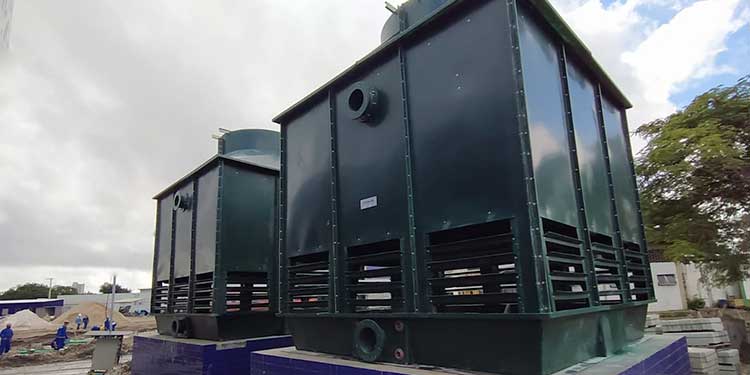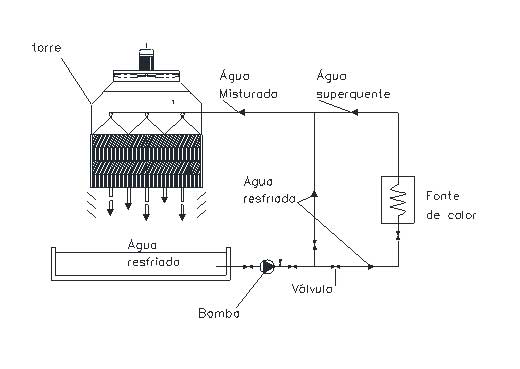
Water Cooling Tower: Successful design and installation
There are many industrial activities obliged to eliminate heat produced and not reusable. Cooling towers are the best and most economical solution. For a successful refrigeration system design and installation, three groups of information are needed:
- Process data: Amount of heat, water flow, hot water temperature, and after cooling;
- Climatic conditions data: Each region has an index called wet-bulb that will influence the entire project;
- Operation data: Tower area, fan airflow, drive power, noise, water treatment, hydraulics, and accessories.
See below for details on each group of information for setting up a water cooling project and installing it.
Process Data
Amount of heat to be dissipated (Q) in kcal/h
It is related to the water flow (Gw) and its hot water temperatures (tw1) in °C and chilled water temperature (tw2) in °C, through the formula Q = Gw x c x (tw1 – tw2) em kcal/h, where c = 1, the specific heat of the water.
Due to its dependence on cooling conditions, the amount of heat is not a value that alone determines the size of a cooling tower.
The flow of water to be cooled (Gw) in m³/h
Optimization of the water flow is necessary since it greatly influences the process and the operating data of the entire process. There are the following relationships:
Very large water flow. Results:
- High pumping energy consumption;
- Low thermal jump, meaning lack of utilization of the cooling tower capacity reserve, that is, evaporation capacity.
Very little water flow. Results:
- Small value for the approach to the wet bulb (approach), meaning a very large cooling tower;
- It results in a very large thermal jump, resulting in large heat exchangers, as a consequence of the process temperatures.
Hot water temperature (tw1) in °C.
The temperature of hot water is directly dependent on the process, for example, on the temperature of the product to be cooled and its temperature gradient. The temperature of the chilled water must be lower than the lowest temperature of the product to be cooled.
Under normal operating conditions, the hot water temperature varies for Brazil from 32 °C to 50 °C.
Some processes have very high hot water temperatures, around 90 °C to 95 °C. Under these conditions, attention should be paid to the materials that will be used in the construction of the cooling tower, in terms of its mechanical stability at high temperatures. Most plastics resist up to 55 °C. Through the use of a piping system with water recirculation, it is possible to lower the temperature of the hot water. See figure below:

Cold-chilled water temperature (tw2) in °C.
The chilled water temperature is the most important value to consider when determining the size of the cooling tower.
The closer the chilled water temperature is to the wet-bulb temperature, the larger the cooling tower. In this way, the designer must observe the real need for very low temperatures.
Thermal jump, z = tw1 – tw2 (°C).
The cooling of water inside a cooling tower is called thermal jump. So: Z = tw1-tw2.
The ideal thermal jump should be between z = 5 a 30 °C, to achieve a safe and economical installation. For thermal jumps smaller than 5 °C the cooling tower is not used sufficiently, while for z greater than 30 °C, the cold water temperature maybe not reached. The basis for this statement is the short time of water/air contact inside the tower, especially in modern installations with compact towers. An efficient solution is the installation of a “by-pass” system, as shown above, or installing 2 towers of the same size with the total gradient equal to the sum of the gradients of each tower.
Approach to the wet bulb, from the English approach (a) in (°C).
It is the difference in temperature between the cooled water (tw2) and the wet-bulb temperature (tf), called the approach to the wet bulb (approach). It has a direct influence on the size of the cooling tower.
Data on the climatic conditions of the place
Dry bulb temperature (tL) and relative humidity (phi).
The dry bulb temperature of the air in the region, as well as its relative humidity (phi), determine the atmospheric air conditions. Psychometric diagrams show the relationship between the mentioned values.
Wet bulb temperature, (tf) in °C.
It is specific to each region and is mentioned in tables. Airport authorities measure wet bulb values constantly. To use the wet bulb temperature of the site, the average of the maximum temperatures measured for each site in the summer months is considered. For design purposes, it should be considered that these values can be exceeded in special conditions in up to 5% of the hours of the day.
Below, see the values of wet bulbs for some regions in °C:
São Paulo – 24
Santos – 27
Campinas – 24
Vitória – 28
Belo Horizonte – 25
Uberlândia – 24
Rio de Janeiro – 27
Curitiba – 23,5
Londrina – 23,5
Foz do Iguaçu – 27
Florianópolis – 26
Joinville – 26
Porto Alegre – 27
Santa Maria – 25,5
Rio Grande – 26
Uruguaiana – 26
Brasília – 24
Goiânia – 26
Cuiabá – 27
Campo Grande – 25
Ponta Porã – 26
São Luiz – 28
João Pessoa – 28
Terezina – 28
Fortaleza – 26
Natal – 27
Recife – 26
Maceió – 27
Salvador - 26
Amapá – 27
Manaus – 29
Santarém – 29
Belém – 27
Germany – 16,5
Argentina – 22
USA – 19
England – 14
Peru – 22
Venezuela – 27
Italy – 18
Chile – 20
Spain – 19
Bolivia – 27
Operation data
The area occupied by the cooling tower
It is a direct function of the operating conditions, that is, water flow and its temperatures. The customer needs to inform us of the space limitations. A cooling tower must not have a rainfall density, ie m³/m².h, greater than 30 m³/m².h for counter-current towers and 50 m³/m².h for cross-current towers.
Tower fan airflow
For the cooling tower to work, it is necessary to move a specific amount of air through the tower. The tower manufacturer must operate at airspeeds that cause little water drag and low-pressure drop. The ideal speed is in the range of 2.5 to 3.5 m/s. Noise and power consumption considerations must be observed.
Cargo loss
It is a function of the constructive form, air inlet window, etc. Each type of fill has a pressure drop, measured in the laboratory. This value is important when calculating the fan drive motor.
Drive motor power
The fan power is of paramount importance as it determines the operating cost of the equipment. As indicative values, basic operation towers should consume from 0.5 to 0.7 kw/m² and “accelerated” towers from 0.7 to 0.9 kw/m².
Types of cooling towers
Different viewpoints determine the type of construction of a cooling tower:
- - Type of ventilation, natural or forced;
- - Round or rectangular cells;
- - In series of blocks;
- - Position of the fan, inflating or vacuuming;
- - Countercurrent or cross current;
For Brazilian climatic conditions, natural ventilation towers are rarely used, with forced ventilation being preferred. The vast majority of installations, except some refineries and in the production of sugar and alcohol, the installed towers are of the compact type, some round, most in counter-current, and some in cross-current.
Noise level
Caravela - Thermotank, manufactures 3 types of cooling towers:
Standard: noise level of 85 dB(A), measured 2 m away from the tower;
Quiet: noise level of 78 dB(A), measured at 2 m away from the tower;
Super quiet: noise level of 72 dB(A), measured at 2 m away from the tower;
Water treatment
For a long, maintenance-free life for your cooling tower, be sure to treat it efficiently.
Flammability of Cooling Towers - Fire Hazard.
Caution. Water cooling towers catch fire when exposed to a heat source, torch type, open flame, etc. Caravela - Thermotank cooling towers can be built with fire-resistant materials. In several categories: Type V0, Type VI, Type V II. In accordance with UL 9 4 – USA.
Hydraulic circuits
Pumps, valve, and piping. They must be dimensioned to support the system flow and the working temperature.
System monitoring
Caravela Thermotank is qualified to install complete control panels, controlling hydraulic pumps - water flows, fans, hot and cooled water temperatures, vibrations, water quality, and others.
Accessories
Ladders, winches, noise mufflers, and others.
CLICK AND LEARN MORE ABOUT DEVELOPING YOUR WATER COOLING TOWER PROJECT


